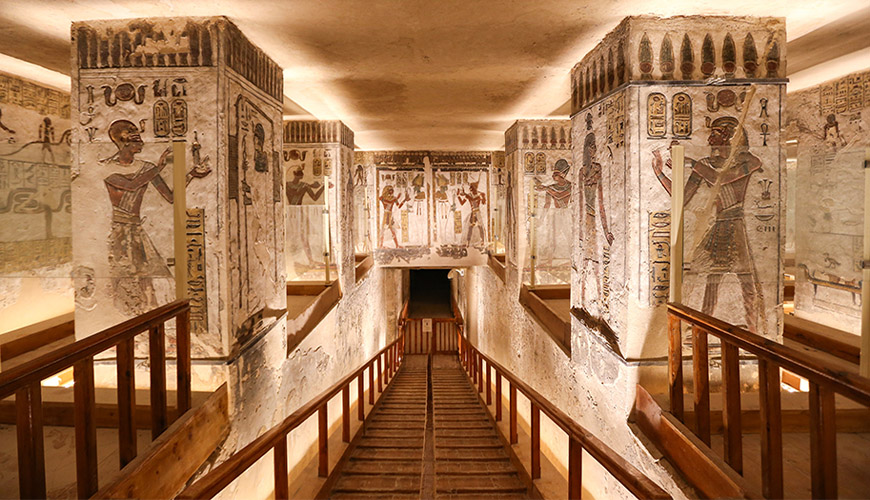The Tomb of Ramesses VI lies within The Valley of the Kings, which is located on the west bank of the Nile near Luxor, stands as a testament to the splendor and grandeur of ancient Egyptian civilization. This tomb is one of the most remarkable and well-preserved tombs from the New Kingdom era. This article aims to unravel the historical, architectural, and artistic aspects of this monumental tomb.
Historical Context: Ramesses VI, the fifth pharaoh of the Twentieth Dynasty, ruled Egypt during the late 12th century BCE. He ascended to the throne after the death of his predecessor, Ramesses V, and continued the legacy of the Ramesside pharaohs. Ramesses VI’s reign was marked by significant architectural achievements, including the construction of his own tomb in the Valley of the Kings.
Architecture and Layout: The tomb of Ramesses VI, designated KV9, is an elaborately designed subterranean complex. Carved into the solid bedrock of the valley, the tomb consists of a series of corridors, chambers, and annexes. The entrance leads to a descending corridor, followed by an antechamber and a burial chamber. The tomb’s depth extends to approximately 100 meters below the surface.
Decorative Elements and Symbolism: The walls of Ramesses VI’s tomb are adorned with vivid and meticulously crafted paintings and carvings that serve both aesthetic and symbolic purposes. The colors used in the artwork, such as red, blue, yellow, and green, were chosen for their symbolic associations with various deities and the afterlife. The use of vibrant hues aimed to create a visually captivating environment and evoke spiritual significance.
Carvings and Paintings: The tomb’s walls feature intricate carvings and paintings that depict scenes from ancient Egyptian mythology, religious rituals, and Ramesses VI’s journey to the afterlife. These scenes include the “Weighing of the Heart” ceremony, where the deceased’s heart is weighed against the feather of Ma’at, symbolizing judgment and the pursuit of eternal life. Other carvings portray offerings to the gods and representations of Ramesses VI accompanied by deities.
Textual Inscriptions: Accompanying the artistic representations are extensive hieroglyphic inscriptions that provide insights into the pharaoh’s genealogy, royal titles, and religious beliefs. These inscriptions also invoke magical spells and prayers intended to guide and protect Ramesses VI in the afterlife. The texts emphasize the pharaoh’s divine lineage and his aspirations for a successful journey through the perilous realms of the netherworld.
Significance and Legacy: The tomb of Ramesses VI is a testament to the pharaoh’s desire for a grand memorial and everlasting remembrance. Its architectural magnificence, intricate artwork, and religious symbolism reflect the ancient Egyptian beliefs in the afterlife and the pharaoh’s divine connections. The tomb serves as an invaluable archaeological and historical resource, shedding light on the religious and funerary practices of the New Kingdom.
In a Nutshell, The tomb of Ramesses VI stands as an exceptional example of ancient Egyptian tomb architecture and artistry. Its historical significance, impressive






